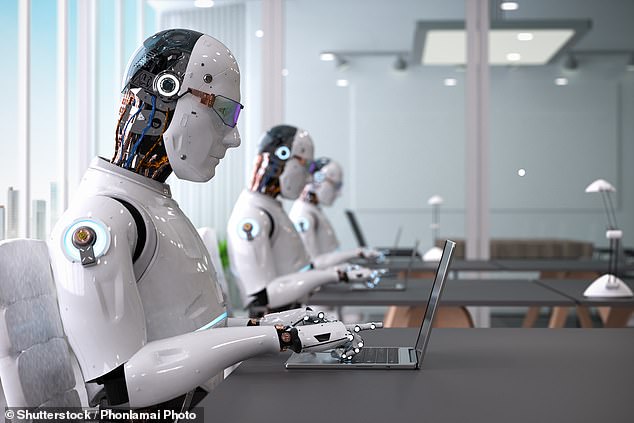By ANDREW NEIL
Published: | Updated:
I have a friend in storage. Not the most glamorous business, to be sure, but lucrative. It’s made him rich and his business is still expanding as he creates new storage facilities for companies and individuals across the country.
It’s a well-run business but in the past year he’s discovered how artificial intelligence, or AI, can make his companies even more productive and profitable.
AI now draws up his planning applications, appeals, associated legal documents and most other complicated paperwork his business requires – and does it in a fraction of the time and cost it took humans. Of course, it means he will need fewer people as his use of AI grows. But those he retains will be far more productive.
At the moment it’s the more menial work that’s being outsourced to the machines. But it won’t be long before AI starts replacing entire professions, starting with accountants and lawyers.
AI’s threat to jobs is scary – some experts talk of a ‘jobs apocalypse’. But a world in which we need fewer accountants and lawyers? Well, every cloud has a silver lining.
My friend’s use of AI is just one small example of the technological revolution sweeping through business and society, with ramifications every bit as far-reaching as the agricultural, industrial and digital revolutions that went before it these past 300 years.
But this time the threat is not to blue-collar jobs – the casualties in previous tech upheavals – but to white-collar jobs, including middle management and above.
Look across the Atlantic and you can see the job losses already beginning to mount. America is always in the vanguard of such trends but what happens there soon happens here, these days with increasing rapidity. The warning signs from the US are already clear: Britain’s middle class needs to prepare for some serious shocks.

Microsoft, which is at the cutting edge of AI developments, is cutting its workforce by 15,000 this year. American behemoths like Amazon (with a market value of $2.5trillion – £1.9trillion) and JPMorgan (the world’s biggest bank) have recently said their workforces will shrink considerably before the decade is out.
The chief executive of Wells Fargo (another US banking giant) even boasts that his headcount has fallen every quarter for five years, thanks largely to deploying AI – a cumulative cut of over 20 per cent to the payroll, with more to come.
Meanwhile, the boss of Ford expects AI to replace half of the car company’s white-collar workforce in the US.
Think tanks compete to put a number on the white-collar jobs in jeopardy: it’s always in the tens of millions. The impact is already being felt by those just starting their careers.
‘What do you hire a 23-year-old university graduate to do these days?’ goes the latest grim joke in corporate America. ‘Nothing. AI can do the work instead.’
It’s not just a joke. In America – and increasingly in Britain – graduate hiring is slowing in every field from information technology to finance to insurance and all manner of services.
Since 2020 in America a diminishing share of university graduates are landing jobs requiring their expensively acquired qualifications. Overall, the US unemployment rate is at about 4 per cent. But it’s 6.6 per cent for new university graduates.
Just ponder the significance of that if you still doubt the job prospects of the well-educated middle class are about to be seriously challenged. Then consider this: the jobless rate among recent US graduates is now rising faster than among young folk without a degree.
Even those who managed to sneak into jobs before the AI revolution gathered steam are in danger. Companies are laying off recent entry-level workers because they’ve discovered AI can do their jobs more cheaply and more efficiently. Well-educated youngsters are now competing for a smaller number of decent entry-level jobs.
Even the high-flyers are suffering. On Wall Street and in the City of London, where big financial operations and law firms are famous for offering the best and the brightest six-figure starting salaries, fewer such posts are up for grabs.
Even well-paid entry-level jobs involve a lot of menial work in the early years. AI is doing that now. So not so many hires are required.
Microsoft this week published a list of the jobs most at risk. It covered just about every white-collar occupation you could think of – sales reps, translators, customer service workers, account clerks, huge swathes of middle management and all manner of analysts. Even photographic fashion models are at risk (AI can create perfect virtual alternatives), as are journalists (gulp) and broadcasters (double gulp).
Microsoft also indicated which jobs were least at risk from AI. They were overwhelmingly blue-collar, involving physical activity, from construction workers to house-cleaners to roustabouts on oil rigs. But some high-grade positions might also be impervious to AI, such as engineers and technicians.
We are only in the foothills of the AI revolution. Until now, AI models are largely being used to augment work – that is to help people do their job better and more efficiently by having AI do the rote stuff while people concentrate on endeavours that add more value.
But the future of AI will involve automation – in which AI actually does the job. That’s when the cull of jobs will be at its most devastating. Already the latest AI tech can beat human performance in a multitude of tasks.
Even older AI models can become surplus to requirements. And they don’t all go quietly. When one company decided to deploy a new AI model to scan its emails, the one being ‘laid off’ threatened to reveal the extramarital affair (discovered in the emails) the project leader was having with a staff member.
So what is to be done? First, do not stand in the way of progress for that is the path to impoverishment. The economic future of America and China looks brighter because they are at the forefront of AI development whereas Europe looks destined to become an economic backwater because it is an AI also-ran.
Second, remember that, in the end, all great tech revolutions generate more jobs than they destroy. True, we do not know what these jobs will be (only politicians are foolish enough to claim they do). That’s what makes it frightening. But it was also true of the digital revolution of the 1980s and 1990s. The world is now awash with jobs that didn’t even exist 20 years ago.
Third, appreciate AI is as much an opportunity as a threat. Ever since the financial crisis of 2008 the world’s major market economies have wallowed in weak productivity growth, nowhere more so than in Britain, which has made for sclerotic economic growth and stagnant living standards.
AI offers an escape route out of this productivity trap leading to a fresh burst of prolonged prosperity (like the Industrial Revolution) – and it is from the wealth created by productivity-led growth that the new, as yet unknown, jobs will come.
Above all, it is time to wake up. Politicians and some commentators across the Western world are obsessing about collapsing birth rates. They want governments to do something about it (they always do).
But if, overall, jobs are going to be in short supply plus, as in Britain’s case, immigration is still at record levels and there are millions of people of working age who don’t work – then it would seem especially perverse in the age of AI to worry about declining populations.
Labour shortages are going to be the least of Britain’s problems in the years to come and the sooner politicians realise that the better.
Poor productivity has reduced Britain to a country in which we must spend more to get less. But AI offers the promise of a future in which we can do a lot more with less. If it means a temporarily bumpy ride for the middle class then it’s no more than the working class has had to endure in previous tech revolutions.
And the prize at the end – a new era of prosperity – is worth the struggle.








